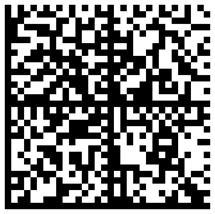QR Bar Codes Saving Lives
 If you are not yet familiar with Quick Response codes (QR codes) you may want to consider educating yourself on them in the near future. QR codes are becoming quite prevalent in nearly all aspects of medicine, and whether or not you work in the medical field, familiarizing yourself with them can significantly benefit you, and may possibly even save your life.
If you are not yet familiar with Quick Response codes (QR codes) you may want to consider educating yourself on them in the near future. QR codes are becoming quite prevalent in nearly all aspects of medicine, and whether or not you work in the medical field, familiarizing yourself with them can significantly benefit you, and may possibly even save your life.
A QR code is a two-dimensional (or Matrix) bar code that can be read by QR Readers, smartphones and computers with web cams. They have recently become increasingly popular in a broad range of contexts outside of the medical field, but are now making a grand entrance into the world of medicine.
If you haven't already noticed, these cute little black and white squares are popping up everywhere. And when they are scanned, you will receive immediate information right at your fingertips. You may see them on billboards advertising Emergency Room wait times, on sample prescription bottles reminding you how to take each specific medication, or on hospital menus allowing you to order your daily meals. Amazingly, doctors can even temporarily tattoo a QR code onto a patient who refuses to wear an ID bracelet.
QR codes are also being utilized in emergency medical situations. As an example of their importance, it should be pointed out that Adverse Drug Reactions (ADRs) are the fourth leading cause of death, accounting for over 100,000 deaths annually. By utilizing QR codes and smartphones, many of these deaths could be prevented. The life-sustaining possibilities are endless.
There are quite a few companies now introducing modernized versions of the classic medical bracelet/ID card. While the classic devises are helpful, only a minute amount of information can be stored on them leaving emergency personnel unable to render complete and prompt medical attention to the the patient in the case of an emergency. With the modernized version, a user can store all vital medical information on the QR code, enabling first responders to scan it at the time of emergency. In many cases, this quick response not only can save lives, but also allows immediate communication between the patient and the first responder.
bracelet/ID card. While the classic devises are helpful, only a minute amount of information can be stored on them leaving emergency personnel unable to render complete and prompt medical attention to the the patient in the case of an emergency. With the modernized version, a user can store all vital medical information on the QR code, enabling first responders to scan it at the time of emergency. In many cases, this quick response not only can save lives, but also allows immediate communication between the patient and the first responder.
One particular company pioneering this technology is Connectyx. They have created a Personal Health and Wellness Management System called MedFlash, which allows users to create an online medical personal profile which is then assigned a unique QR code. Instead of carrying around a card, users can have the code printed anywhere they feel would be most useful.
Another company, Lifespire, a non-profit organization which helps developmentally disabled persons reach their goals, has developed another version of the emergency QR code. These codes are stored on small plastic tags, typical to something you might see hanging from a key chain. Mark van Voorst, CEO of Lifespire, says that the life tags are a “powerful and potentially life-saving tool for anyone to carry.”
This merge in healthcare and mobile technology seems to be only at the beginning stages. As this technology advances, hopefully we will all begin to see more effective healthcare, and ideally, less fatalities.
Sources:
http://www.qrcodepress.com/lifespire-brings-qr-codes-to-a-new-age-medical-bracelet/853469/
Related Articles:
http://www.barcode.com/20110719623/tag-what-it-is-where-its-going-an-interview-with-microsoft.html
http://www.barcode.com/20110511550/qr-code-growth-astounding-naked-facts-released.html
http://www.barcode.com/the-naked-truth-about-qr-codes.html
{jcomments on}
